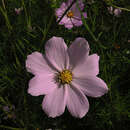en
names in breadcrumbs


Cosmos bipinnatus, commonly called the garden cosmos or Mexican aster,[2] is a medium-sized flowering herbaceous plant in the daisy family Asteraceae, native to the Americas. The species and its varieties and cultivars are popular as ornamental plants in temperate climate gardens.[3][4][5][6]
Cosmos bipinnatus is considered a half-hardy annual, although plants may reappear via self-sowing for several years. The plant height varies from 2-6 ft to (rarely) 9 ft (0.61–1.83–2.74 m). The cultivated varieties appear in shades of pink and purple as well as white. The branched stem is usually densely to occasionally occupied by fine, split up, rough trichomes, some specimens are completely hairless. The petiole itself is inconspicuous, winged, 10 (rarely to 15) mm (25⁄64–19⁄32 in) long, sometimes the leaves are almost sessile.
The partial leaves are linear-filiform to narrow linear with a width of 0.5 to 1 (rarely to 1.7) mm (3⁄128–5⁄128–9⁄128 in); the tips are pointed, hardened, but not particularly sharp. Its foliage is finely cut into threadlike segments. When flowering, the plant can become top heavy. This problem is alleviated when grown in groups, as the bipinnate leaves interlock, and the colony supports itself.[7]
The achenes become blackish, are smooth or short-bristly. Their shape is spindle-like. They are rounded off into a short, 0.5 to 1.7 millimetres (3⁄128 to 9⁄128 in) long, but distinctly pronounced rostrum. The inner achenes are up to 18 millimetres (91⁄128 in) long, their yellowish beaks are 4 to 5 (rarely to 10) mm (5⁄32–25⁄128–25⁄64 in) long. A pappus is missing or it consists only of two to three awn-like, 1 to 3 millimetres (5⁄128 to 15⁄128 in) large bristles.[8]

The very conspicuous cup-shaped inflorescences have a diameter of usually 5 to 7 (rarely 8) cm (25⁄128–35⁄128–5⁄16 in) and contain tongue and tubular flowers, which are surrounded by bracts. The outer bracts are usually eight and are ovate to lanceolate-tail-shaped, 7 to 15 millimetres (35⁄128 to 19⁄32 in) long, 3 to 5 (rarely 6) mm (15⁄128–25⁄128–15⁄64 in) wide. The inner bracts are ovate-lanceolate and 8 to 12 millimetres (5⁄16 to 15⁄32 in) long. They are translucent with many black stripes and a clear edge up to 1 mm wide, sometimes with yellowish or pink pigments, the tip is ciliate. The sprout leaves have gold-yellow, thread-like tips and protrude between the tubular flowers. The broadened base of these spreader leaves is translucent, provided with a yellow line. During flowering, the plant can sag under its weight. This problem can be solved by grouping the feet together so that the leaves hang together.
The mostly eight ray florets are pink to violet or white colored, at the base may show noticeable stains caused by anthocyanin. The tongues are reversely ovate shaped, have a length of usually 20 to 35 millimetres (25⁄32 to 1+3⁄8 in) (16 to 40 millimetres (5⁄8 to 1+37⁄64 in)) and a width of usually 12 to 20 millimetres (15⁄32 to 25⁄32 in) (8 to 25 millimetres (5⁄16 to 63⁄64 in)). The tips are almost dull and have three broad, wavy teeth. Below that, they are greatly rejuvenated. In the center of the flower baskets is a large number of tubular flowers (also called disc florets), whose overgrown petals are yellow, turn white in the lower part and reach a length of 5 to 6 millimetres (25⁄128 to 15⁄64 in). The anthers are brownish-black and about 3 millimetres (15⁄128 in) long, at the tips are short-triangular, translucent attachments with a length of 0.5 to 0.8 millimetres (3⁄128 to 1⁄32 in). The branches of the stylus are short and rather dull, with a length of 0.5 millimetres (3⁄128 in).[9]
Garden Cosmos is native to Mexico, Guatemala and Costa Rica. Since it is used as an ornamental plant in many countries and prone to sedimentation, it is an invasive plant in many areas of the world. It has naturalized in scattered locations across North America, South America, the West Indies, Italy, Australia, and Asia, where it is a garden escape (introduced species) and in some habitats becoming a weed.[7]
Cultivars of Cosmos bipinnatus in cultivation today include:
(those marked agm have gained the Royal Horticultural Society's Award of Garden Merit).
Growth characteristics of this plant include:
Excessive rain can cause cultivation problems, due to the delicate nature of the stems. Heavy rain can cause breakage. Cosmos bipinnatus can tolerate heat as long as adequate moisture is provided, however, it does not handle droughts, strong winds or cold temperatures well. Snails, slugs and aphids have a taste for Cosmos bipinnatus. Successfully cultivated plants can mature 2 to 4 feet (0.61 to 1.22 m) x 12 to 18 inches (300 to 460 mm).[25]
The flowers of Cosmos bipinnatus attract birds and butterflies,[25] including the monarch butterfly. It can be part of butterfly gardening and pollinator/honey-bee habitat gardens.[25]
Andrena sp. pollinating
Cosmos bipinnatus, commonly called the garden cosmos or Mexican aster, is a medium-sized flowering herbaceous plant in the daisy family Asteraceae, native to the Americas. The species and its varieties and cultivars are popular as ornamental plants in temperate climate gardens.